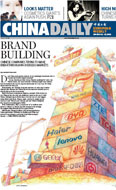Chen Weihua
Safety key to plans for nuclear power
Updated: 2011-03-15 07:57
By Chen Weihua (China Daily)
The fight to avoid a disaster at Japan's Fukushima Daiichi nuclear power plant after the devastating 9.0-magnitude earthquake should serve as a warning to China that it must exercise caution in its ambitious nuclear energy program over the coming decades.
On Sunday, Xie Zhenhua, deputy director of the National Development and Reform Commission, said that the country will strengthen the monitoring and assessment of its nuclear power stations. This was after the Vice-Minister of Environmental Protection Zhang Lijun said on Saturday that China will draw lessons from the Japanese experience in mapping out its nuclear power development strategy, but reaffirmed the country's unwavering commitment to developing nuclear energy.
| ||||
Under the plan, China will raise the percentage of electricity produced by nuclear power from the current 1 percent to 6 percent by 2020. The proportion in the United States is around 20 percent with 104 nuclear power plants in 31 states. The world's average in 2009 was between 13-14 percent.
There is no doubt that nuclear power remains one of the cleanest sources of energy, given the fact that it produces no carbon dioxide, sulfur dioxide or nitrogen oxide.
However, that has not been enough to persuade everyone of the benefits of nuclear power, especially after the tragic accidents at Three Mile Island in the US in 1979 and Chernobyl in the former Soviet Union in 1986. The unfolding situation in Japan is another reminder of the potential consequences of any catastrophe at a nuclear power plant.
That is especially true in China considering the huge population density. Many nuclear power plants, such as Qinshan in Hangzhou Bay and Daya Bay between Shenzhen and Hong Kong, are located in areas populated by tens of millions of people.
It has been fortunate for China that there has been no nuclear leaks at the 13 units now in operation. These days officials and experts have been extolling the safety features of the mostly third-generation nuclear power plants that China is going to build.
But what's happening in Japan shows that a disaster is still possible even in a country that is widely regarded as the nation most prepared for earthquakes and with the strictest safety standards.
According to the International Atomic Energy Authority, a fifth of the 443 working commercial nuclear power stations in the world are located in areas of "significant" seismic activity. With some 350 new reactors expected to be built in the next 20 years the risk of a catastrophe from a natural disaster is growing significantly.
That means that China has a tough job ahead making sure that the dozens of nuclear power plants it plans to build over the next decade are located away from areas prone to seismic disasters. It would be unimaginable if an earthquake, like the one in Sichuan province on May 12, 2008, were followed by a nuclear meltdown.
As some have already pointed out, assessment and monitoring are vital in any construction projects in China since construction projects have involved so much corruption in the past decades. A shoddily constructed nuclear power plant is thousands of times worse than poorly built bridges and apartment buildings. It could literally wipe out a city.
While we pray for the Japanese and hope a catastrophe at Fukushima Daiichi nuclear plant can be averted, we should do everything we can to make every single one of our nuclear power plants the safest in the world and the safest for centuries to come. There should be zero tolerance for any negligence.
The author is deputy editor of China Daily US edition. E-mail: chenweihua@chinadaily.com.cn
(China Daily 03/15/2011 page9)
E-paper

Factory fever
Despite auto manufacturing bubble scare, car giants gear up expansion of factories.
Dressed for success
Fabric of change
High spirits
Specials

Earthquake Hits Japan
A massive 8.8 magnitude quake hit the northeast coast of Japan on March 11,2011.

NPC & CPPCC sessions
Lawmakers and political advisers gather in Beijing to discuss major issues.

Panda campaign
Black-and-white bear helps Chengdu in marketing campaign after quake.



